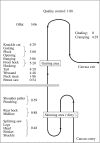Group A streptococcal skin infection outbreak in an abattoir: lessons for prevention
- PMID: 17291367
- PMCID: PMC2870572
- DOI: 10.1017/S0950268806006819
Group A streptococcal skin infection outbreak in an abattoir: lessons for prevention
Abstract
During a group A streptococcus (GAS) outbreak 21 abattoir workers developed skin infections. The unusual outbreak strain (emm 108.1) was cultured from five workers and four persons in the community with links to the abattoir. The attack rate was 26% in the lamb line. Communal nailbrushes were neither routinely disinfected nor changed, and had high bacterial counts. A cohort study found a higher risk from working in the gutting area and getting cuts on hands more than weekly. Despite high bacterial counts daily nailbrush use had a lower risk, as did always wearing disposable gloves. Working in the gutting area (OR 11.44) and nailbrush use at least once a day (OR 0.04) were significant in the multivariate model. Transmission of infection is likely to have occurred on carcasses. GAS infection among abattoir workers was once common. Simple hygiene measures, such as nailbrush use, may reduce the impact of future outbreaks.
Figures

 , Carcass transport.
, Carcass transport.

Similar articles
-
An outbreak of skin sepsis in abattoir workers caused by an 'unusual' strain of Streptococcus pyogenes.J Med Microbiol. 2000 Apr;49(4):371-374. doi: 10.1099/0022-1317-49-4-371. J Med Microbiol. 2000. PMID: 10755633
-
A prolonged outbreak of streptococcal infection among workers at a meat plant.Public Health. 1996 Mar;110(2):81-4. doi: 10.1016/s0033-3506(96)80051-5. Public Health. 1996. PMID: 8901249
-
Group A beta-hemolytic streptococcal skin infections in a US meat-packing plant.JAMA. 1987 Dec 4;258(21):3131-4. JAMA. 1987. PMID: 2959800
-
Epidemiology and prevention of skin and soft tissue infections.Cutis. 2004 May;73(5 Suppl):3-7. Cutis. 2004. PMID: 15182157 Review.
-
Group A Streptococcus Toxic Shock Syndrome: An outbreak report and review of the literature.J Infect Public Health. 2012 Dec;5(6):388-93. doi: 10.1016/j.jiph.2012.07.006. Epub 2012 Nov 30. J Infect Public Health. 2012. PMID: 23287609 Review.
Cited by
-
A scoping review of zoonotic parasites and pathogens associated with abattoirs in Eastern Africa and recommendations for abattoirs as disease surveillance sites.Front Public Health. 2023 Jul 17;11:1194964. doi: 10.3389/fpubh.2023.1194964. eCollection 2023. Front Public Health. 2023. PMID: 37529427 Free PMC article.
-
Molecular Detection of Tick-Borne Pathogens in Kumasi: With a First Report of Zoonotic Pathogens in Abattoir Workers.Biomed Res Int. 2024 Jul 14;2024:4848451. doi: 10.1155/2024/4848451. eCollection 2024. Biomed Res Int. 2024. PMID: 39035771 Free PMC article.
References
-
- PHLS Working Group on Streptococcal Infection in Meat Handlers. Prevention of streptococcal sepsis in meat handlers. Communicable Disease Report. 1983;83:3–4.
-
- Tsai TF, Parker MT Pathogenic Streptococci. Oxford, UK. Chertsey: Reedbooks; 1979. Mode of spread of Group-A streptococci in an abattoir outbreak of wound sepsis; pp. 118–119. , pp.
-
- Fehrs LJ et al. Group A β-hemolytic streptococcal skin infections in a US meat-packing plant. Journal of the American Medical Association. 1987;258:3131–3134. - PubMed
-
- Public Health Laboratory Service Working Group on Streptococcal Infection in Meat Handlers. The epidemiology and control of streptococcal sepsis in meat handlers. Environmental Health. 1982;10:256–258.
MeSH terms
LinkOut - more resources
Full Text Sources
Medical

